Kia Forte: Alternator / Battery
Specifications
▷CMF60L - DIN
Item
|
Specification
|
Capacity [20 hr / 5 hr] (AH)
|
60 / 48
|
Cold Cranking Amperage (A)
|
550 (SAE) / 440 (EN)
|
Reserve Capacity (Min)
|
92
|
Specific Gravity
|
1.27 - 1.29 [25°C(77°F)]
|
Voltage (V)
|
12
|
| • |
Model type description
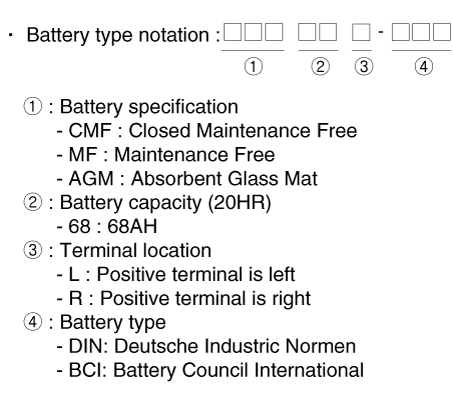
|
| • |
Cold Cranking Ampere (CCA): Cold Cranking Amps is a rating used
in the battery industry to define a battery's ability to start an
engine in cold temperatures.
|
| – |
The rating is the number of amps a new, fully charged battery
can deliver at -18 °C(-0.4 °F) for 30 seconds, while maintaining
a voltage of at least 7.2 volts for a 12 volt battery.
|
| – |
The higher the CCA rating, the greater the starting power of
the battery.
|
| • |
RESERVE CAPACITY (RC) : Reserve Capacity is a battery industry
rating, defining a battery's ability to power a vehicle with an
inoperative alternator or fan belt.
|
| – |
The rating is the number of minutes a battery at 26.7 °C(80 °F)
can be discharged at 25 amps and maintain a voltage of 10.5 volts
for a 12 volt battery.
|
| – |
The higher the reserve rating, the longer your vehicle can operate
should your alternator or fan belt fail.
|
|
|
BCI Type
Capacity
(5 hr / 20 hr)
|
Length
|
Width
|
Height
|
Total Height
|
L (mm)
|
W (mm)
|
H (mm)
|
TH (mm)
|
28/35
|
188 - 192
|
126 - 130
|
198 - 202
|
218 - 222
|
32/40
|
194 - 198
|
133 - 137
|
199 - 203
|
223 - 227
|
36/45
|
203 - 207
|
173 - 177
|
200 - 204
|
221 - 225
|
44/55
|
213 - 217
|
173 - 177
|
198 - 202
|
218 - 222
|
48/60
|
228 - 232
|
173 - 177
|
200 - 204
|
221 - 225
|
54/68
|
258 - 262
|
173 - 177
|
198 - 202
|
220 - 224
|
56/70
|
258 - 262
|
173 - 177
|
198 - 202
|
223 - 227
|
64/80
|
274 - 278
|
170 - 174
|
198 - 202
|
221 - 225
|
70/88
|
349 - 353
|
172 - 176
|
186 - 200
|
183 - 187
|
72/90
|
300 - 304
|
170 - 174
|
200 - 204
|
221 - 225
|
76/95
|
294 - 298
|
172 - 176
|
198 - 202
|
220 - 224
|
80/100
|
326 - 330
|
170 - 174
|
203 - 207
|
225 - 229
|
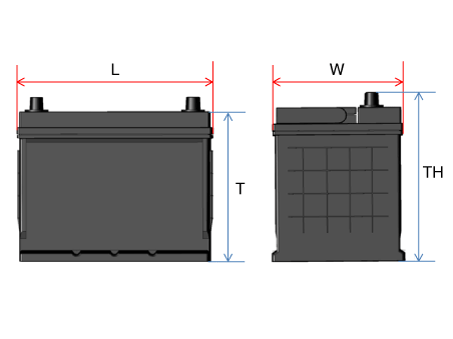
DIN Type
Capacity
(5 hr / 20 hr)
|
Length
|
Width
|
Height
|
Total Height
|
L (mm)
|
W (mm)
|
H (mm)
|
TH (mm)
|
36/45
|
205 - 207
|
173 - 175
|
164 - 168
|
188 - 190
|
48/60
|
240 - 242
|
173 - 175
|
164 - 168
|
188 - 190
|
54/68
|
276 - 278
|
173 - 175
|
164 - 168
|
188 - 190
|
64/80
|
313 - 315
|
173 - 175
|
164 - 168
|
188 - 190
|
72/90
|
351 - 353
|
173 - 175
|
164 - 168
|
188 - 190
|
80/100
|
351 - 353
|
173 - 175
|
164 - 168
|
188 - 190
|
88/110
|
392 - 394
|
173 - 175
|
164 - 168
|
188 - 190
|
AGM DIN Type
Capacity
(5 hr / 20 hr)
|
Length
|
Width
|
Height
|
Total Height
|
L (mm)
|
W (mm)
|
H (mm)
|
TH (mm)
|
40/50
|
205 - 207
|
173 - 175
|
164 - 168
|
188 - 190
|
48/60
|
227 - 229
|
173 - 175
|
164 - 168
|
188 - 190
|
56/70
|
276 - 278
|
173 - 175
|
164 - 168
|
188 - 190
|
64/80
|
312 - 314
|
173 - 175
|
164 - 168
|
188 - 190
|
72/90
|
351 - 353
|
173 - 175
|
164 - 168
|
188 - 190
|
84/105
|
392 - 394
|
173 - 175
|
164 - 168
|
188 - 190
|
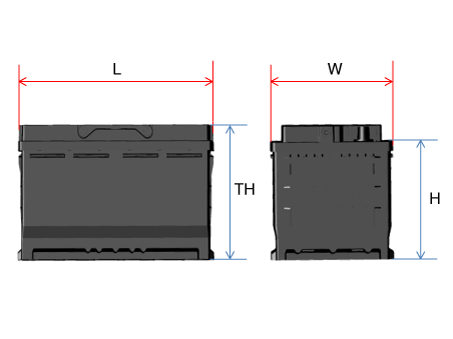
|
Description and operation
| 1. |
The CMF (Closed Maintenance Free) battery is, as the name implies, totally
maintenance free and has no removable battery cell caps.
|
| 2. |
The CMF (Closed Maintenance Free) battery does not require water replenishment
for the repair.
|
| 3. |
The battery is completely sealed, except for small vent holes in the
cover.
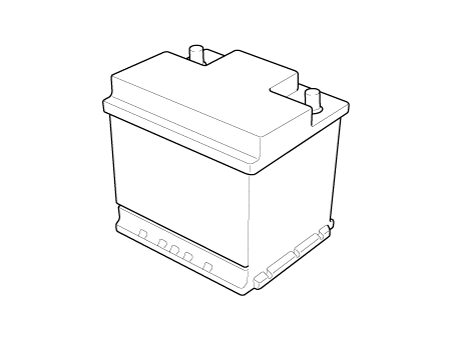
|
| • |
After disconnecting then reconnecting the battery negative cable,
reset some parts that require the reset procedures.
(Refer to Body Electrical System - "General Information")
|
|
Repair procedures
| • |
After disconnecting then reconnecting the battery negative cable,
reset some parts that require the reset procedures.
(Refer to Body Electrical System – "General Information")
|
|
Battery
| 1. |
Turn the ignition switch OFF.
|
| 2. |
Disconnect the battery negative (-) terminal (A).
|
Battery negative (-) terminal tightening nut :
8.0 - 10.0 N·m (0.8 - 1.0 kgf·m, 5.9 - 7.4 lb·ft)
|
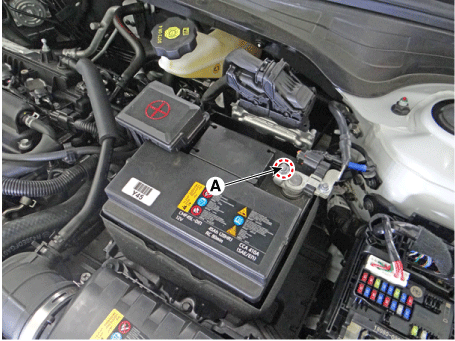
|
| 3. |
Disconnect the battery positive (+) terminal (A).
|
Battery positive (+) terminal tightening nut :
8.0 - 10.0 N·m (0.8 - 1.0 kgf·m, 5.9 - 7.4 lb·ft)
|
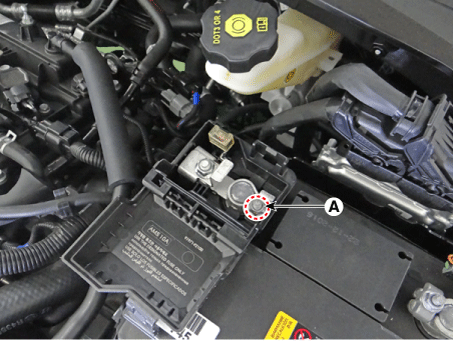
|
| 4. |
Remove the battery mounting bracket after loosening the mounting bolt
(A).
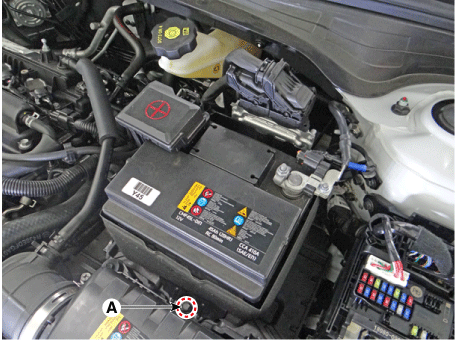
|
| 5. |
Remove the battery (A).
|
Battery mounting bracket mounting bolt :
9.0 - 14.0 N·m (0.9 - 1.4 kgf·m, 6.6 - 10.3 lb·ft)
|
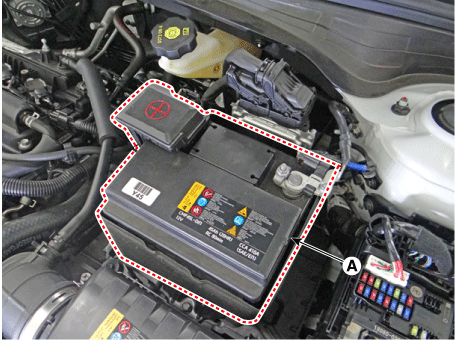
|
Battery Tray
| 1. |
Remove the battery.
(Refer to Charging System - "Battery")
|
| 2. |
Remove the air cleaner.
(Refer to Engine Mechanical System - "Air Cleaner")
|
| 3. |
Disconnect the ECM connector (A).
|
| 4. |
Remove the mounting bolts and nut, and then remove the ECM bracket assembly
(B).
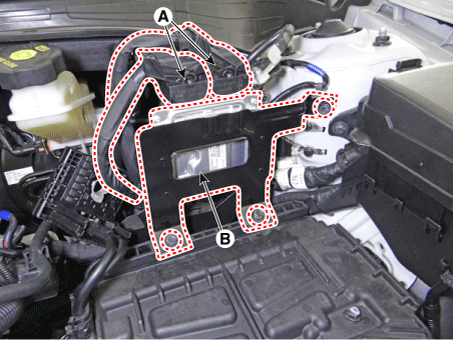
|
| 5. |
Remove the battery tray (A) after loosening the mounting bolts
|
Battery tray mounting bolt:
9.0 - 14.0 N·m (0.9 - 1.4 kgf·m, 6.6 - 10.3 lb·ft)
|
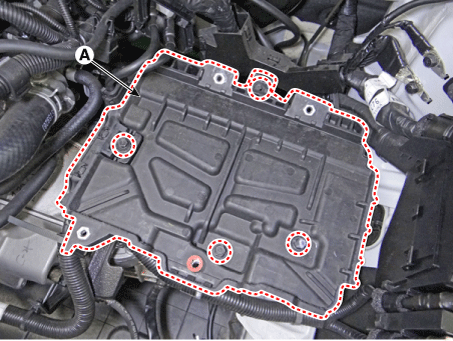
|
| 6. |
Install in the reverse order of removal.
| •
|
When installing the battery, fix the mounting bracket
on the tray correctly.
|
|
| •
|
After disconnecting then reconnecting the battery negative
cable, reset some parts that require the reset procedures.
(Refer to Body Electrical System – "General Information")
|
|
|
In general, vehicle battery charging system has three forms.
| 1. |
Constant current charge: The battery voltage gradually rises by charging
with setting a constant current. If charging current and time are not managed
correctly, the battery is over-charged, therefore charging should be stopped
after confirming the completion of charging.
| – |
General charge: Charging the battery for a long time with low
current
|
| – |
Quick charge: Charging the battery for a short time with high
current
|
|
| 2. |
Constant voltage charge: The battery charge current is gradually reduced
by charging with setting a constant voltage.
|
|
If the battery is charged directly at the battery terminals on vehicles
with battery sensor, misinterpretations of battery condition and under certain
circumstances also unwanted Check Control messages or fault memory entire
can occur.
After recharging finished, let the battery stand for over 10 hours with
normal temperature for battery stabilization.
|
Battery Voltage and Status
Check the battery voltage and status using the battery tester.
Battery Terminal
| 1. |
Move back and forth to check that the battery terminals (A) are loose
or corroded.If the terminals are corroded, clean them.


If battery positive connection is loose, disconnect ground(GND) cable
first before attempting to remove or tighten plus connection, to prevent
personal injury.
|
| 2. |
If the battery clamp on battery positive (+) terminal is not seated securely:
| (1) |
Turn ignition switch OFF and disconnect the battery negative
(-) terminal.
|
| (2) |
Tighten battery clamp (A) on battery positive (+) terminal
|
Battery positive (+) terminal:
8.0 - 10.0 N·m (0.8 - 1.0 kgf·m, 5.9 - 7.4 lb·ft)
|

|
|
| 3. |
If the battery clamp on battery negative (-) terminal is not seated securely:
| (1) |
Tighten battery clamp (A) on battery negative (-) terminal.
|
Battery negative (-) terminal:
8.0 - 10.0 N·m (0.8 - 1.0 kgf·m, 5.9 - 7.4 lb·ft)
|

|
|
Battery Condition
Check the battery for damage or deformation. If severe damage, deformation or
leakage is found, replace the battery.
Vehicle parasitic current inspection
[Using the Ammeter]
| 1. |
Turn the all electric devices OFF, and then turn the ignition switch
OFF.
|
| 2. |
Close all doors except the engine hood, and then lock all doors.
| (1) |
Disconnect the hood switch connector.
|
| (3) |
Close the doors or remove the door switches.
|
|
| 3. |
Wait a few minutes until the vehicle’s electrical systems go to sleep
mode.
| •
|
For an accurate measurement of a vehicle parasitic current,
all electrical systems should go to sleep mode. (It takes
at least one hour or at most one day.) However, an approximate
vehicle parasitic current can be measured after 10-20 minutes.
|
|
|
| 4. |
Connect an ammeter in series between the battery (-) terminal and the
ground cable, and then disconnect the clamp from the battery (-) terminal
slowly.
| •
|
Be careful that the lead wires of an ammeter do not come
off from the battery (-) terminal and the ground cable to
prevent the battery from being reset. In case the battery
is reset, connect the battery cable again, and then start
the engine or turn the ignition switch ON for more than
10 sec. Repeat the procedure from No. 1.
To prevent the battery from being reset during the inspection,
|
| 1) |
Connect a jump cable between the battery (-) terminal
and the ground cable.
|
| 2) |
Disconnect the ground cable from the battery (-) terminal.
|
| 3) |
Connect an ammeter between the battery (-) terminal and
the ground cable.
|
| 4) |
After disconnecting the jump cable, read the current
value of the ammeter.
|
|
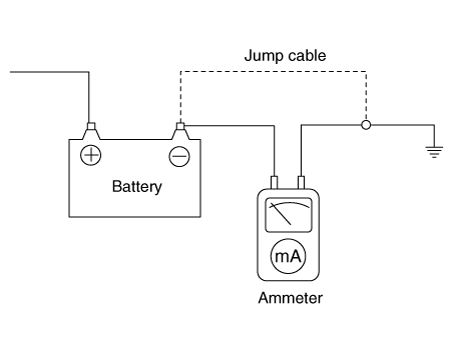
|
| 5. |
Read the current value of the ammeter.
| • |
If the parasitic current is over the limit value, search for
abnormal circuit by removing a fuse one by one and checking the
parasitic current.
|
| • |
Reconnect the suspected parasitic currentdraw circuit fuse only
and search for suspectedunit by removing the component connected
with thecircuit one by one until the parasitic draw dropsbelow limit
value.
|
|
Limit value (after 10-20 min.) : Below 50mA
|
|
[Using the Clamp type Ammeter]
| 1. |
Turn the all electric devices OFF, and then turn the ignition switch
OFF.
|
| 2. |
Close all doors except the engine hood, and then lock all doors.
| (1) |
Disconnect the hood switch connector.
|
| (3) |
Close the doors or remove the door switches.
|
|
| 3. |
Wait a few minutes until the vehicle’s electrical systems go to sleep
mode.
| •
|
For an accurate measurement of a vehicle parasitic current,
all electrical systems should go to sleep mode. (It takes
at least one hour or at most one day.) However, an approximate
vehicle parasitic current can be measured after 10-20 minutes.
|
|
|
| 4. |
Install the clamp type ammerter on battery negative (-) terminal.
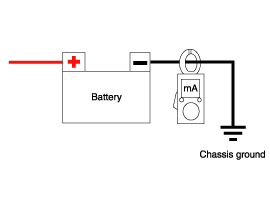
|
| 5. |
Read the current value of the ammeter.
| • |
If the parasitic current is over the limit value, search for
abnormal circuit by removing a fuse one by one and checking the
parasitic current.
|
| • |
Reconnect the suspected parasitic currentdraw circuit fuse only
and search for suspectedunit by removing the component connected
with thecircuit one by one until the parasitic draw dropsbelow limit
value.
|
|
Limit value (after 10-20 min.) : Below 50mA
|
|
The Micro 570 Analyzer provides the ability to test the charging and starting
systems, including the battery, starter and alternator.
|
※ Because of the possibility of personal injury, always use extreme caution
and appropriate eye protection when working with batteries.
※ When charging battery by test result, Battery must be fully charged.
To get accurate test result, battery surface voltage must have subsided
ahead before test when you test battery after charged. (See following Battery
Test Results)
|
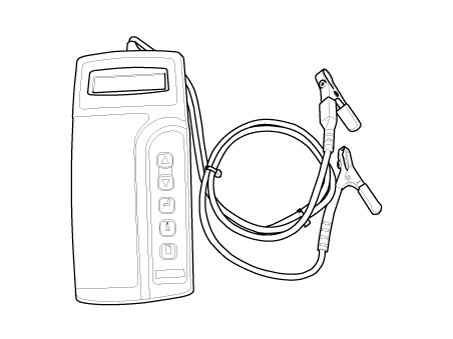
Keypad
The Micro 570 button on the key pad provide the following functions :
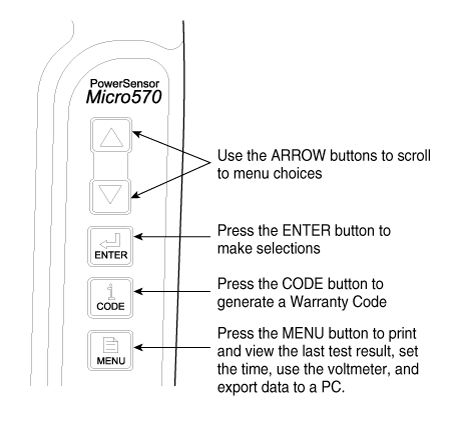
Battery Test Procedure
| 1. |
Connect the tester to the battery.
| – |
Red clamp to battery positive (+) terminal.
|
| – |
Black clamp to battery negative (-) terminal.
|
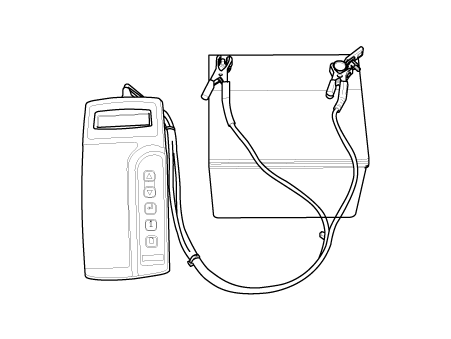
| •
|
Connect clamps securely. If "CHECK CONNECTION" message
is displayed on the screen, reconnect clamps securely.
|
|
|
| 2. |
The tester will ask if the battery is connected "IN-VEHICLE" or "OUT-OF-VEHICLE".
Make your selection by pressing the arrow buttons; then press ENTER.
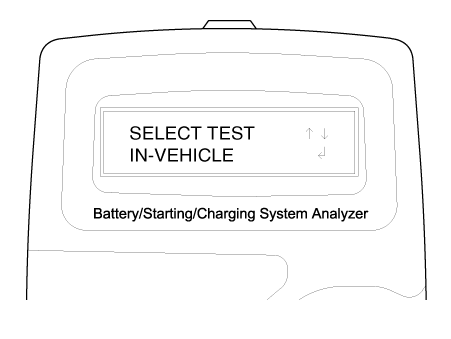
|
| 3. |
Select CCA and press the ENTER button.
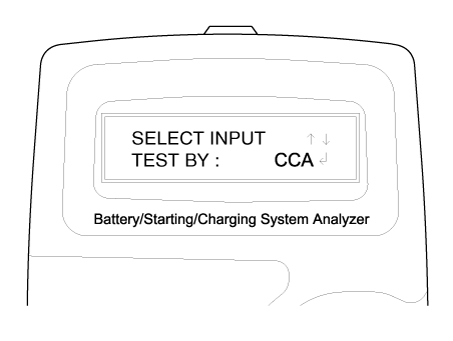
| •
|
CCA : Cold cranking amps, is an SAE specification for
cranking batteried at -0.4°F (-18°C).
|
|
|
| 4. |
Set the CCA value displayed on the screen to the CCA value marked on
the battery label by pressing up and down buttons and press ENTER.
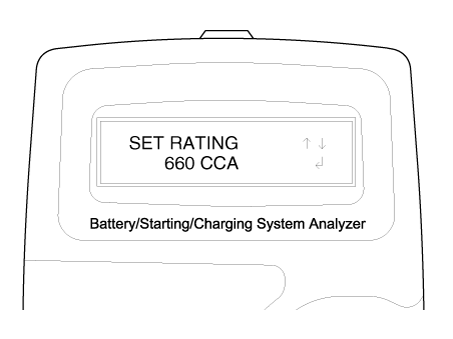
| •
|
The battery ratings(CCA) displayed on the tester must
be identical to the ratings marked on battery label.
|
|
|
| 5. |
The tester will conduct battery test.
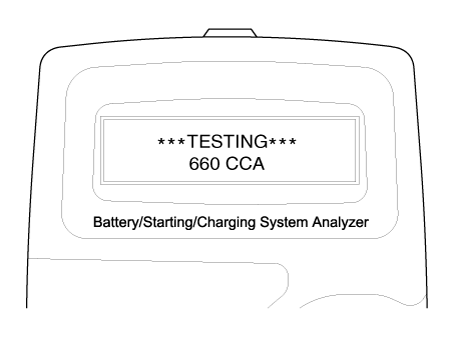
|
| 6. |
The tester displays battery test results including voltage and battery
ratings.
Refer to the following table and take the appropriate action as recommended
by the Micro 570.
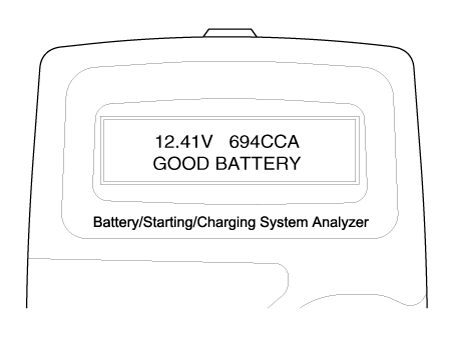
Battery Test Results
Result On Printer
|
Remedy
|
GOOD BATTERY
|
No action is required.
|
GOOD RECHARGE
|
Battery is in a good state.
Recharge the battery and use.
※ You have to follow instruction below when you charge battery and
retest, otherwise test result can be inaccurate. (See ‘Charge and
Retest method after battery charge’ below.)
|
CHARGE & RETEST
|
Battery is not charged properly.
| –
|
Charge and test the battery again.
|
※ You have to follow instruction below when you charge battery and
retest, otherwise test result can be inaccurate. (See ‘Charge and
Retest method after battery charge’ below.)
|
REPLACE BATTERY
|
Replace battery and recheck the charging system.
| –
|
Improper connection between battery and vehicle cables
may cause "REPLACE BATTERY". Retest the battery after removing
cables and connecting the tester to the battery terminal
directly prior to replacing the battery.
|
|
BAD CELL-REPLACE
|
Charge and retest the battery.
| –
|
If the Micro 570 recommends "REPLACE BATTERY", replace
the battery and recheck the charging system.
|
|
[Charge and Retest method after battery charge]
Battery charge
Set battery charger to ‘Auto Mode’ (The Mode that charging current drops
as the battery charges.) and charge battery until charging current down
close to zero or the charger alerts you with an alarm when charge is complete.
(Minimum charging time recommended: More than 3 hours with Auto Mode
that explained above)
| • |
If battery is not fully charged, battery surface voltage will
be high while the amount of current charged (CCA) in battery is
low. If you measure the battery under this condition, tester may
misjudge that battery sulfation occurred because the amount of current
in battery is too low in comparison with battery voltage.
* Surface voltage: When battery is charged electrolyte temperature
increases and chemical reaction become active resulting in an excessive
increase of battery voltage.
It is known that it takes approximate one day to subside this
increased surface voltage completely.
|
Battery Test after charge
Do not test battery right after the charge. Test battery after battery
surface voltage has subsided as instructed in the following procedure.
| (1) |
When battery charge is complete, install the battery in the vehicle.
|
| (2) |
Put IG key to ON position and turn on head lamp with low beam,
and wait 5 minutes. (Discharge for 5 minutes)
|
| (3) |
Turn off the head lamp and IG key, and wait 5 minutes. (Waiting
for 5 minutes)
|
| (4) |
Remove +, - cable from the battery and test battery.
|
| •
|
Whenever filing a claim for battery, the print out of
the battery test results must be attached.
|
|
Starter Test Procedure
|
| 7. |
After the battery test, press ENTER immediately for the starter test.
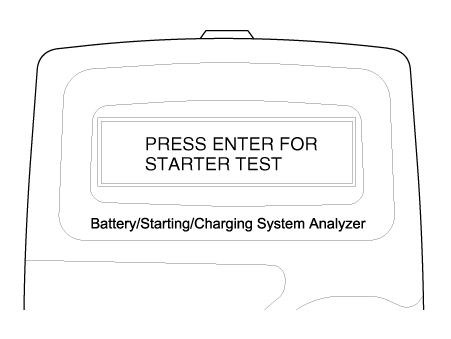
|
| 8. |
Start the engine.
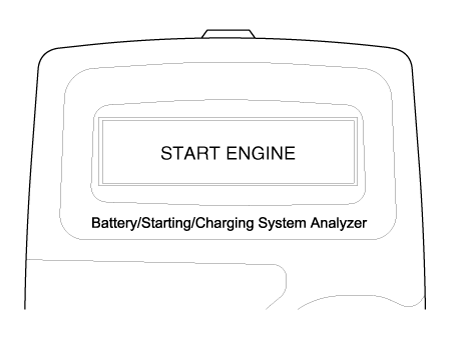
|
| 9. |
Cranking voltage and starter test results will be displayed on the screen.
Refer to the following table and take the appropriate action as recommended
by the Micro 570.
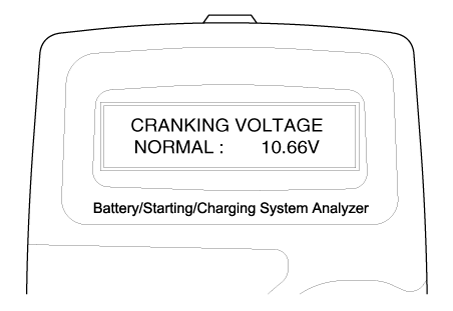
Starter Test Results
Result On Printer
|
Remedy
|
CRANKING VOLTAGE NORMAL
|
System shows a normal starter draw.
|
CRANKING VOLTAGE LOW
|
Cranking voltage is lower than normal level.
|
CHARGE BATTERY
|
The state of battery charge is too low to test.
| –
|
Charge the battery and retest.
|
|
REPLACE BATTERY
|
Replace battery.
| –
|
If the vehicle is not started though the battery condition
of "GOOD BATTERY" is displayed, check wiring for open circuit,
battery cable connection, starter and repair or replace
as necessary.
|
| –
|
If the engine does crank, check fuel system.
|
|
| •
|
When testing the vehicle with old diesel engines, the
test result will not be favorable if the glow plug is not
heated. Conduct the test after warming up the engine for
5 minutes.
|
|
Charging System Test Procedure
|
| 10. |
Press ENTER to begin charging system test.
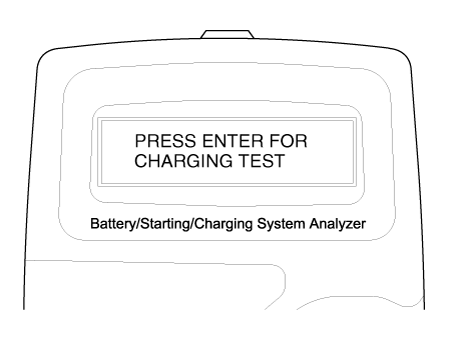
|
| 11. |
The tester displays the actual voltage of alternator.
Press ENTER to continue.
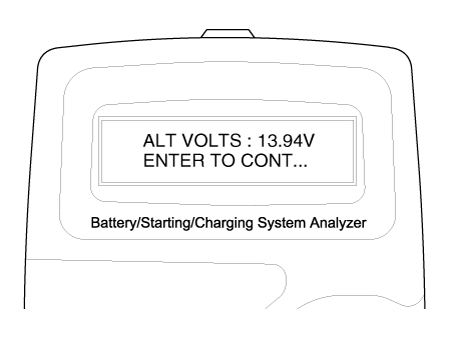
|
| 12. |
Turn off all electrical load and rev engine for 5 seconds with pressing
the accelerator pedal. (Follow the instructions on the screen)
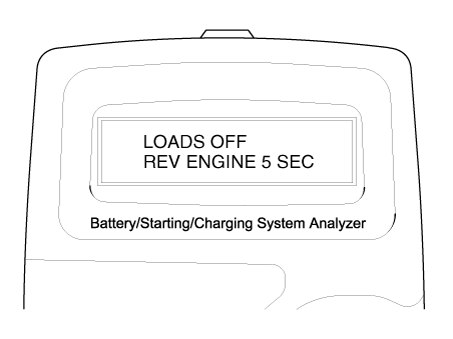
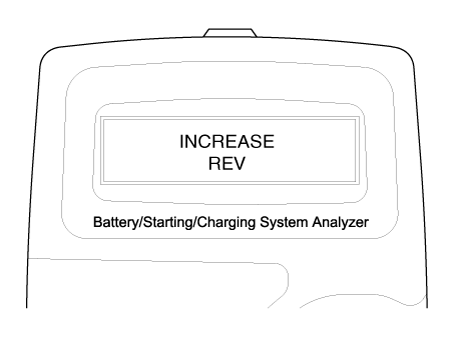
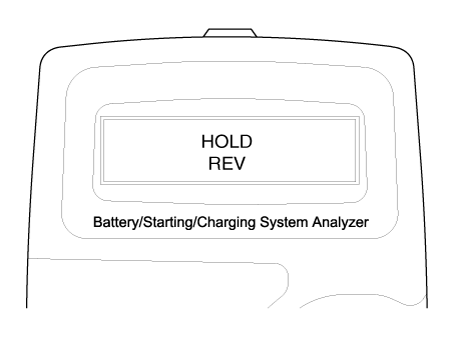
|
| 13. |
The message that engine RPM is detected will be displayed on the screen.
Press ENTER to continue.
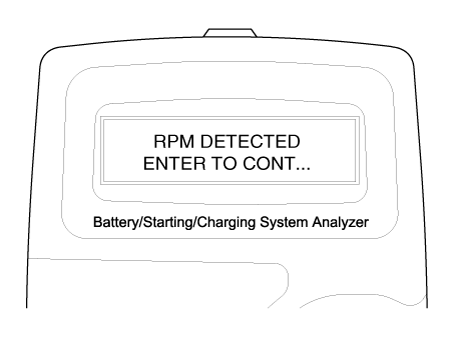
|
| 14. |
If the engine RPM is not detected, press ENTER after revving engine.
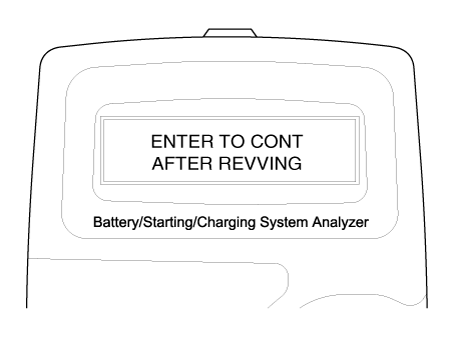
|
| 15. |
The tester will conduct charging system test during loads off.
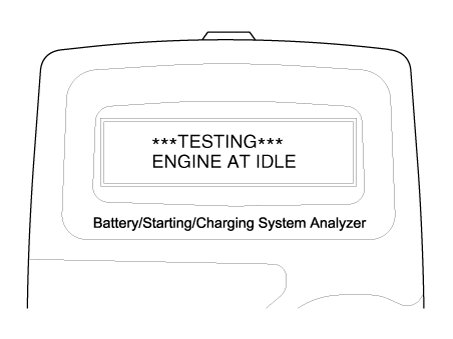
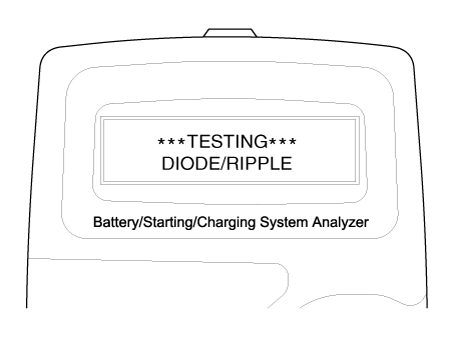
|
| 16. |
Turn on electrical loads (air conditioner, lamps, audio and etc). Press
ENTER to continue.
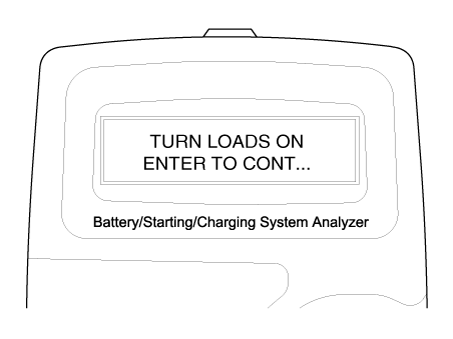
|
| 17. |
The tester will conduct charging system test during loads on.
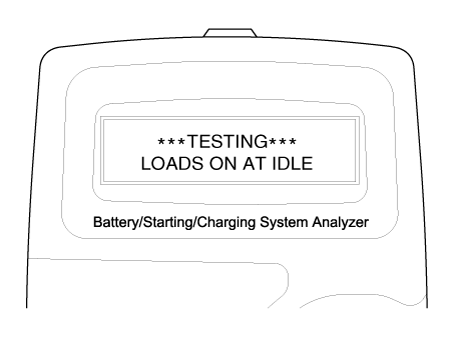
|
| 18. |
Rev engine for 5 seconds with pressing the accelerator pedal. (Follow
the instructions on the screen)
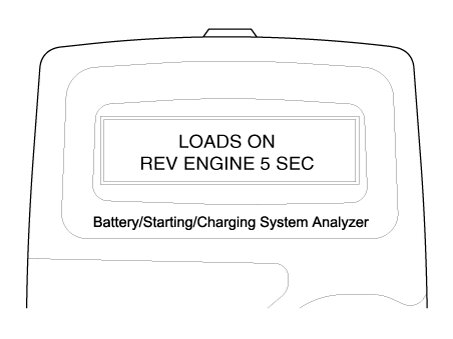
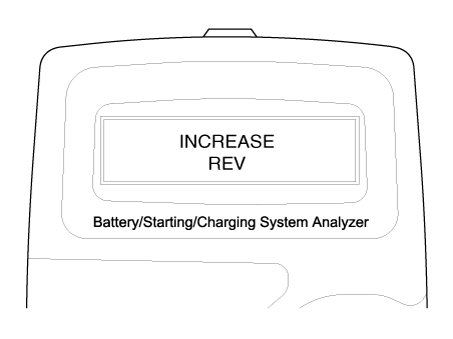
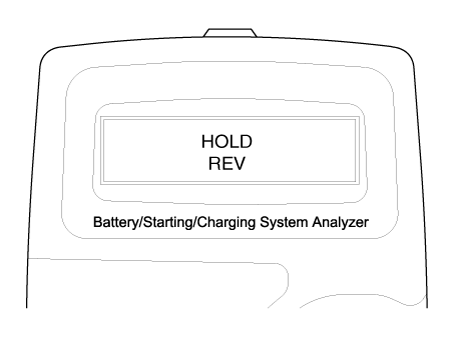
|
| 19. |
The message that engine RPM is detected will be displayed on the screen.
Press ENTER to continue.
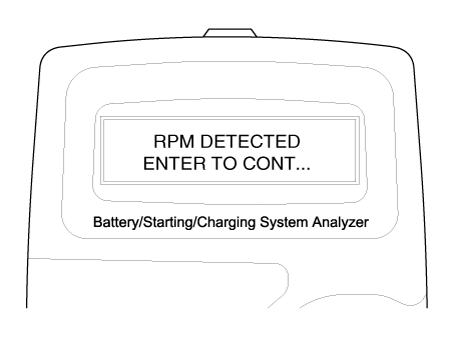
|
| 20. |
If the engine RPM is not detected, press ENTER after revving engine.
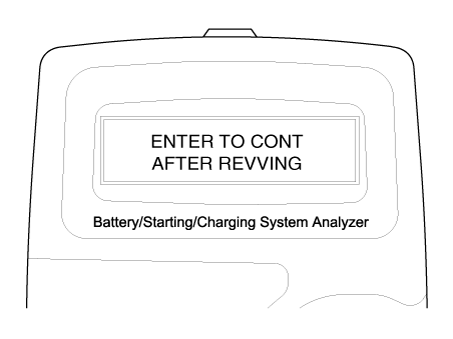
|
| 21. |
Turn off electrical loads (air conditioner, lamps, audio and etc). Turn
the engine off.
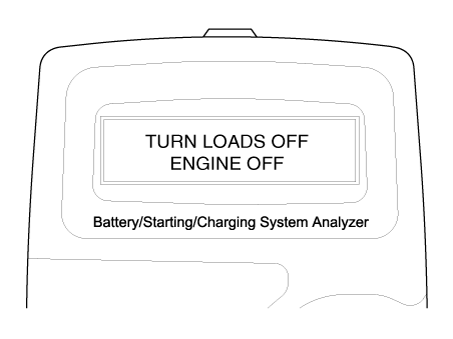
|
| 22. |
Charging voltage and charging system test results will be displayed on
the screen.
Shut off engine end disconnect the tester clamps from the battery. Refer
to the following table and take the appropriate action as recommended by
the Micro 570.
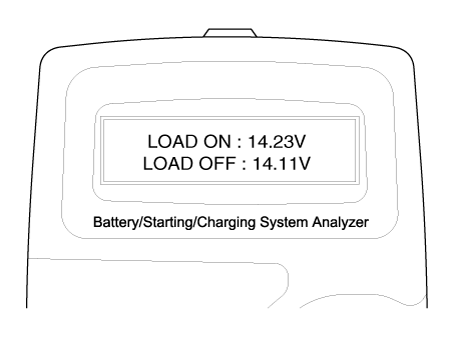
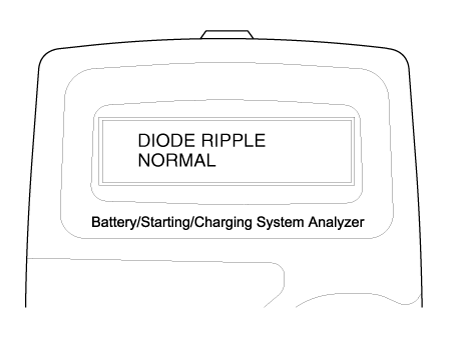
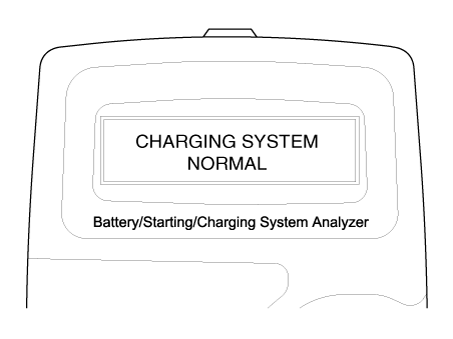
Charging System Test Results
Result On Printer
|
Remedy
|
CHARGING SYSTEM NORMAL / DIODE RIPPLE NORMAL
|
Charging system is normal.
|
NO CHARGING VOLTAGE
|
Alternator does not supply charging current to battery.
| –
|
Check belts, connection between alternator and battery
and replace belts or cable or alternator as necessary.
|
|
LOW CHARGING VOLTAGE
|
Alternator does not supply charging current to battery and electrical
load to system fully.
| –
|
Check belts and alternator and replace as necessary.
|
|
HIGH CHARGING VOLTAGE
|
The voltage from alternator to battery is higher than normal limit
during voltage regulating.
| –
|
Check connection and ground and replace regulator as
necessary.
|
| –
|
Check electrolyte level in the battery.
|
|
EXCESS RIPPLE DETECTED
|
One or more diodes in the alternator is not functioning properly.
| –
|
Check alternator mounting and belts and replace as necessary.
|
|
|
The MDX-670P Analyzer
The MDX-670P battery conductance and electrical system analyzer tests batteries
as well as starting and charging systems for vehicle.
It displays the test results in seconds and features a built-in printer to provide
a copy of the results.
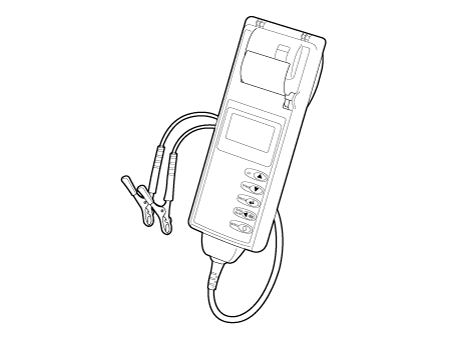
| 1) |
Because of the possibility of personal injury, always use extreme
caution and appropriate eye protection when working with batteries.
|
| 2) |
When charging battery by test result, Battery must be fully charged.
To get accurate test result, battery surface voltage must have subsided
ahead before test when you test battery after charged. (See following
Battery Test Results)
|
|
| • |
When testing the vehicle with old diesel engines, the test result
will not be favorable if the glow plug is not heated. Conduct the
test after warming up the engine for 5 minutes.
|
|
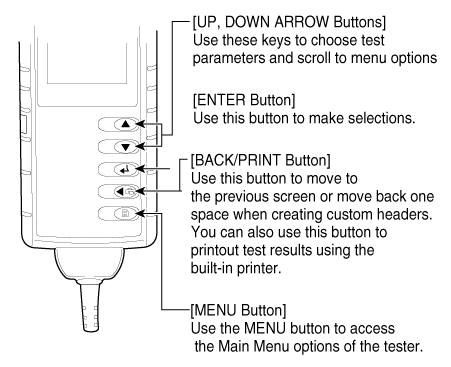
| 1. |
Connect the red clamp to the positive (+) terminal and the black clamp
to the negative (–) terminal.
| •
|
For a proper connection, rock the clamps back and forth.
The tester requires that both sides of each clamp be firmly
connected before testing. A poor connection will produce
a CHECK CONNECTION or WIGGLE CLAMPS message. If the message
appears, clean the terminals and reconnect the clamps.
|
|
|
| 2. |
Scroll to and select IN VEHICLE or OUT OF VEHICLE for a battery not connected
to a vehicle.
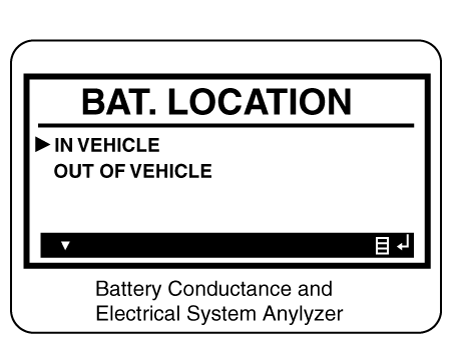
| •
|
Following an IN VEHICLE test you will be prompted to
test the starting and charging systems.
|
|
|
| 3. |
Scroll to and select REGULAR FLOODED, AGM FLAT PLATE, or AGM SPIRAL where
applicable.
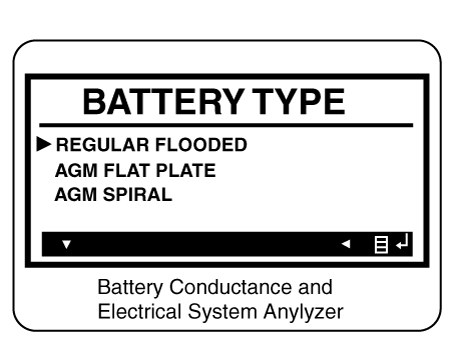
| •
|
If the vehicle equipped with ISG function, select the
AGM FLAT PLATE.
|
|
|
| 4. |
Scroll to and select the battery’s rating system.
| •
|
Mostly, the CCA value is marked on the battery label,
but sometimes marked EN or SEA value. Select one of them.
|
|
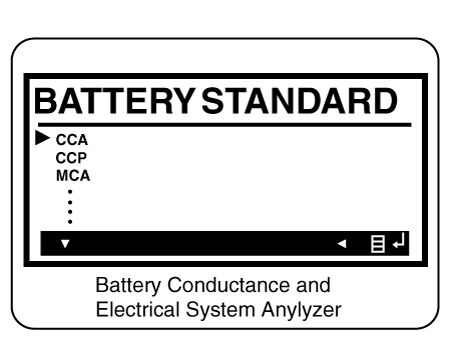
| – |
CCA: Cold Cranking Amps, as specified by SAE. The most common
rating for cranking batteries at 0 °F (-17.8 °C).
|
| – |
SAE: Society of Automotive Engineers, the European labeling of
CCA
|
|
| 5. |
Set the selected rating value displayed on the screen to the value marked
on the battery label by pressing up and down arrow buttons.
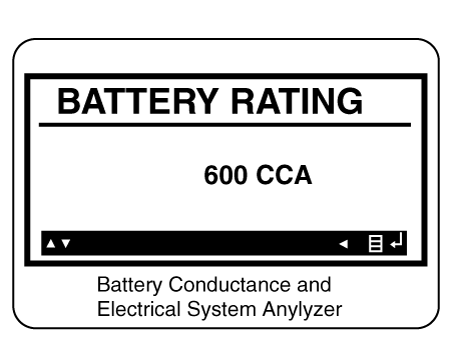
|
| 6. |
Press ENTER to start test.
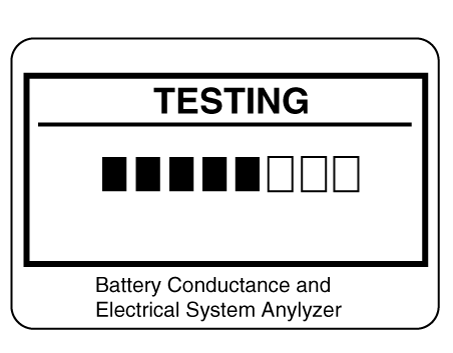
|
| 7. |
After several seconds the tester displays the decision on the battery’s
condition and the measured voltage. The tester also displays your selected
battery rating and the rating units.
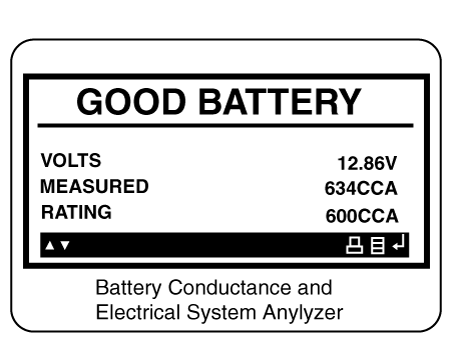
Battery Test Results
Result On Printer
|
Remedy
|
GOOD BATTERY
|
No action is required.
|
GOOD RECHARGE
|
Battery is in a good state. Recharge the battery and use.
※ You have to follow instruction below when you charge battery and
retest, otherwise test result can be inaccurate. (See ‘Charge and
Retest method after battery charge’ below.)
|
CHARGE & RETEST
|
Battery is not charged properly.
| –
|
Charge and test the battery again.
|
※ You have to follow instruction below when you charge battery and
retest, otherwise test result can be inaccurate. (See ‘Charge and
retest method after battery charge’ below.)
|
REPLACE BATTERY
|
Replace battery and recheck the charging system.
| –
|
Improper connection between battery and vehicle cables
may cause "REPLACE BATTERY", retest the battery after removing
cables and connecting the tester to the battery terminal
directly prior to replacing the battery.
|
|
BAD CELLREPLACE
|
Charge and retest the battery.
| –
|
If recommends "REPLACE BATTERY", replace the battery
and recheck the charging system.
|
|
[Charge and Retest method after battery charge]
Battery charge
Set battery charger to ‘Auto Mode’ (The Mode that charging current drops
as the battery charges.) and charge battery until charging current down
close to zero or the charger alerts you with an alarm when charge is complete.(Minimum
charging time recommended: More than 3 hours with Auto Mode that explained
above)
| • |
If battery is not fully charged, battery surface voltage will
be high while the amount of current charged (CCA) in battery is
low. If you measure the battery under this condition, tester may
misjudge that battery sulfation occurred because the amount of current
in battery is too low in comparison with battery voltage.
* Surface voltage: When battery is charged electrolyte temperature
increases and chemical reaction become active resulting in an excessive
increase of battery voltage.
It is known that it takes approximate one day to subside this
increased surface voltage completely.
|
Battery Test after charge
Do not test battery right after the charge. Test battery after battery
surface voltage has subsided as instructed in the following procedure.
| (1) |
When battery charge is complete, install the battery in the vehicle.
|
| (2) |
Put IG key to ON position and turn on head lamp with low beam,
and wait 5 minutes. (Discharge for 5 minutes)
|
| (3) |
Turn off the head lamp and IG key, and wait 5 minutes. (Waiting
for 5 minutes)
|
| (4) |
Remove +, - cable from the battery and test battery.
|
| •
|
For an in-vehicle test, the display alternates between
the test results and the message “PRESS FOR STARTER TEST.
|
|
| •
|
Before starting the test, inspect the alternator drive
belt. A belt that is glazed or worn, or lacks the proper
tension, will prevent the en¬gine from achieving the rpm
levels needed for the test.
|
|
|
| 8. |
Press the ENTER button to proceed with the starter test.
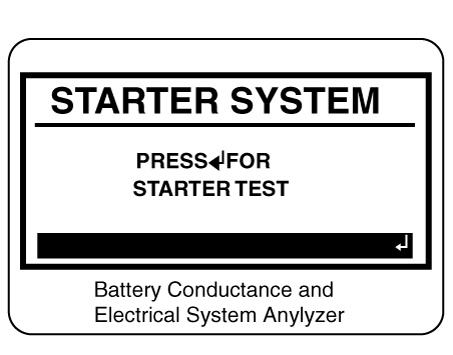
|
| 9. |
Start the engine when prompted.
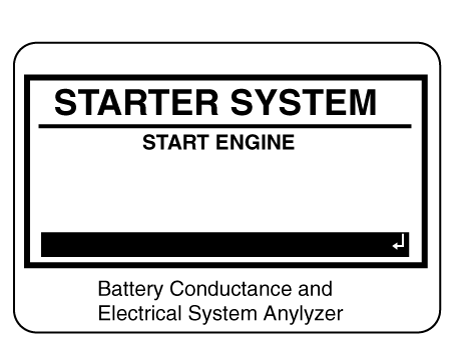
|
| 10. |
The tester displays the decision on the starter system, cranking voltage,
and cranking time in milliseconds.
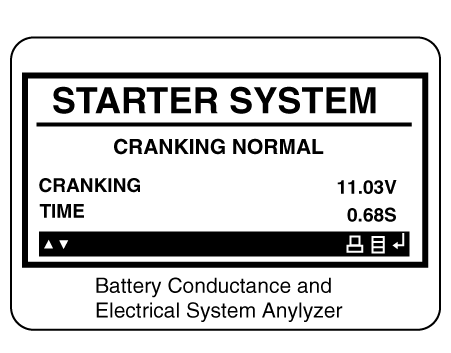
Starter Test Results
Result On Printer
|
Remedy
|
CRANKING VOLTAGE NORMAL
|
System shows a normal starter draw.
|
CRANKING VOLTAGE LOW
|
Cranking voltage is lower than normal level.
|
CHARGE BATTERY
|
The state of battery charge is too low to test.
| –
|
Charge the battery and retest.
|
|
REPLACE BATTERY
|
Replace battery.
| –
|
If the vehicle is not started though the battery condition
of "GOOD BATTERY" is displayed, check wiring for open circuit,
battery cable connection, starter and repair or replace
as necessary.
|
| –
|
If the engine does crank, check fuel system.
|
|
| •
|
For an in-vehicle test, the display alternates between
the test results and the message “PRESS FOR CHARGING TEST.
|
|
Step 3: Charging System Test
|
| 11. |
Press the ENTER button to proceed with the charging test.
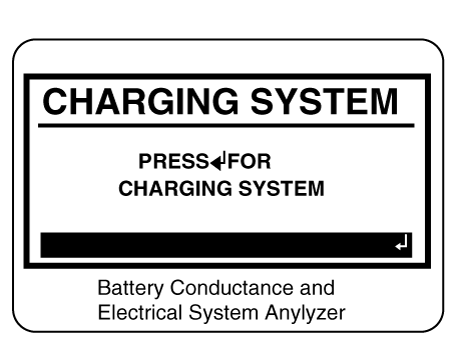
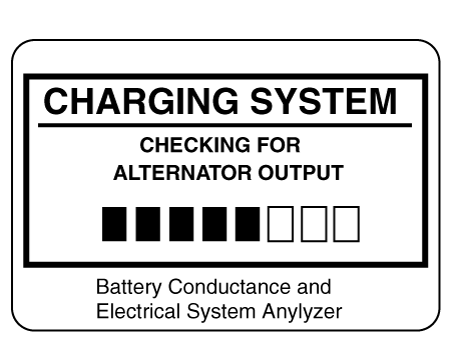
|
| 12. |
Rev the engine with loads off. (Following the on-screen prompts)
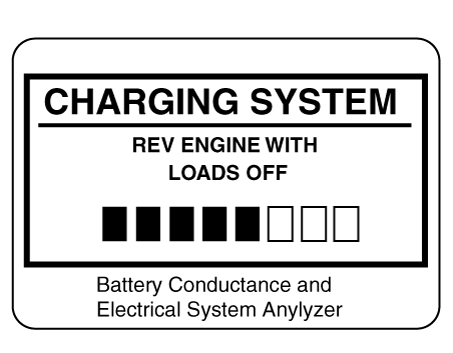
|
| 13. |
The message that engine RPM is detected will be displayed on the screen,
idle the engine.
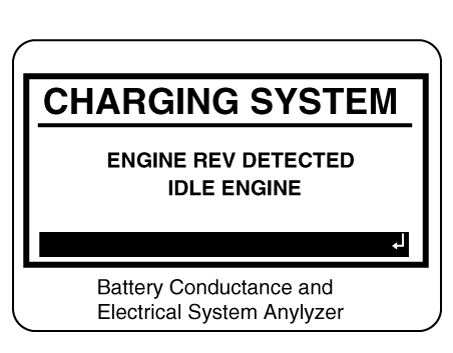
|
| 14. |
Turn on electrical loads (air conditioner, lamps, audio and etc). Press
ENTER to continue.
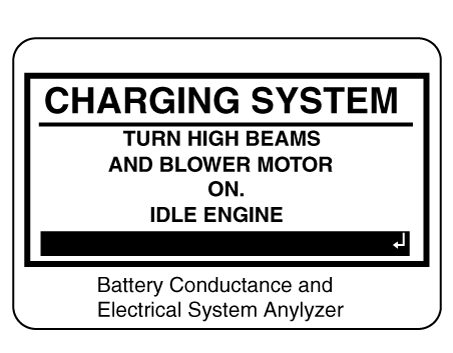
|
| 15. |
Turn on electrical loads (air conditioner, lamps, audio and etc). Press
ENTER to continue.
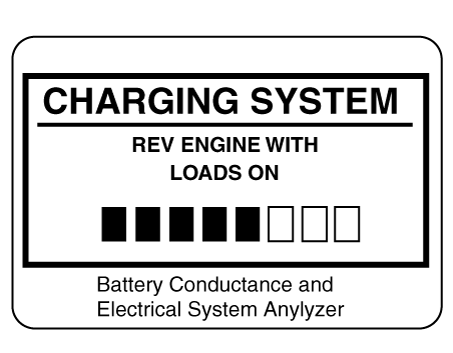
|
| 16. |
The message that engine RPM is detected will be displayed on the screen,
idle the engine.
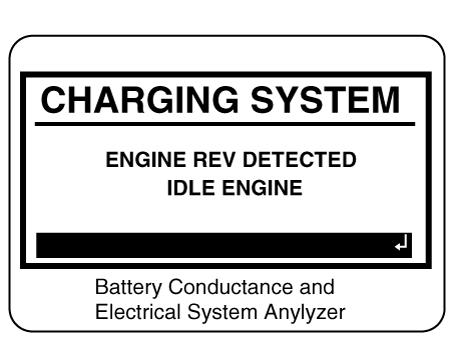
|
| 17. |
Turn off loads and engine.
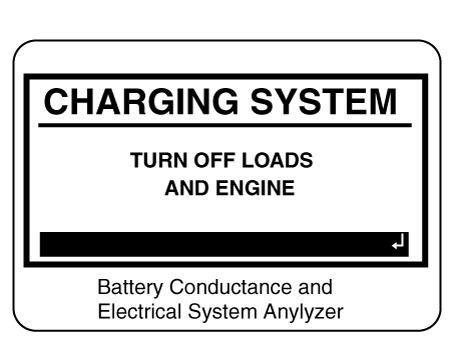
|
| 18. |
The Charging System decision is displayed at the end of the procedure.
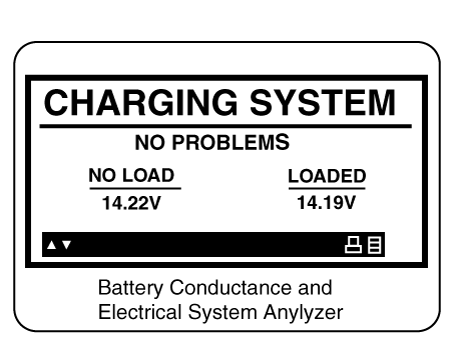
Result On Printer
|
Remedy
|
NO PROBLEMS
|
System is showing normal output from the alternator.
|
NO OUTPUT
|
No alternator output detected.
| –
|
Check all connections to and from the alternator, especially
the connection to the battery. If the connection is loose
or heavily corroded, clean or replace the cable and retest.
|
| –
|
If the belts and connections are in good working condition,
replace the alternator. (Older vehicles use external voltage
regulators, which may require only replacement of the voltage
regulator.)
|
|
LOW OUTPUT
|
Alternator does not supply charging current to battery and electrical
load to system fully.
| –
|
Check belts and alternator and replace as necessary.
|
|
HIGH OUTPUT
|
The voltage from alternator to battery is higher than normal limit
during voltage regulating.
| –
|
Check connection and ground and replace regulator as
necessary.
|
| –
|
Check electrolyte level in the battery.
|
|
EXCESSIVE RIPPLE
|
The voltage from alternator to battery is higher than normal limit
during voltage regulating.
| –
|
Check alternator mounting and belts and replace as necessary.
|
|
CHARGE BATTERY
|
The starter voltage is low and the battery is discharged. Fully
charge the battery and repeat the starter system test.
|
REPLACE BATTERY
|
Battery must be replaced before the starting system can be tested.
|
|
| 19. |
Press the BACK/PRINT button to print the test results or MENU to return
to the Options Menu.
|
| 1. |
Make sure the ignition switch and all accessories are in the OFF position.
|
| 2. |
Disconnect the battery cables (negative first).
|
| 3. |
Remove the battery from the vehicle.
| •
|
Care should be taken in the event the battery case is
cracked or leaking, to protect your skin from the electrolyte.
Heavy rubber gloves (not the household type) should be
wore when removing the battery.
|
|
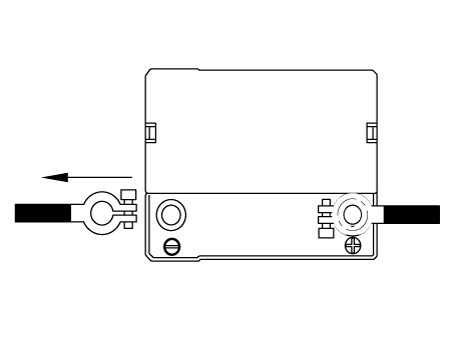
|
| 4. |
Inspect the battery tray for damage caused by the loss of electrolyte.
If acid damage is present, it will be necessary to clean the area with a
solution of clean warm water and baking soda. Scrub the area with a stiff
brush and wipe off with a cloth moistened with baking soda and water.
|
| 5. |
Clean the top of the battery with the same solution as described above.
|
| 6. |
Inspect the battery case and cover for cracks. If cracks are present,
the battery must be replaced.
|
| 7. |
Clean the battery posts with a suitable battery post tool.
|
| 8. |
Clean the inside surface of the terminal clamps with a suitable battery
cleaning tool. Replace damaged or frayed cables and broken terminal clamps.
|
| 9. |
Install the battery in the vehicle.
|
| 10. |
Connect the cable terminals to the battery post, making sure tops of
the terminals are flush with the tops of the posts .
|
| 11. |
Tighten the terminal nuts securely.
|
| 12. |
Coat all connections with light mineral grease after tightening.
| •
|
When batteries are being charged, an explosive gas forms
beneath the cover of each cell. Do not smoke near batteries
being charged or which have recently been charged. Do not
break live circuit at the terminals of batteries being charged.
A spark will occur when the circuit is broken. Keep open
flames away from battery.
|
|
|
Troubleshooting
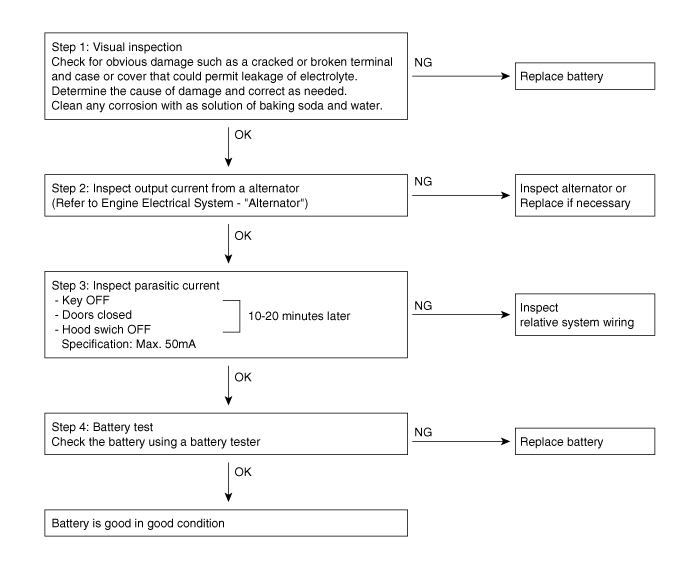
Specifications
Specification
Item
Specification
Rated voltage
13.5V, 130A
Speed in use
1,000 - 18,000 ...
Description and operation
Description
Vehicles have many control units that use more electricity. These units control
their own system based on information from diverse sensors. It is ...
Other information:
Components and components location
Components
1. Rear door trim
2. Rear door lower channel
3. Rear door hinge
4. Rear door delta inner cover
5. Rear door belt inside weatherstrip
6. Rear door belt outside weatherstrip
7. Rear door delta molding ...
Specifications
Specifications
Item
Specified
Type
ON / OFF
Operating condition
Neutral gear
Operating voltage
10 V - 15 V
Operating temperature
...





 Alternator
Alternator Battery Sensor
Battery Sensor































































